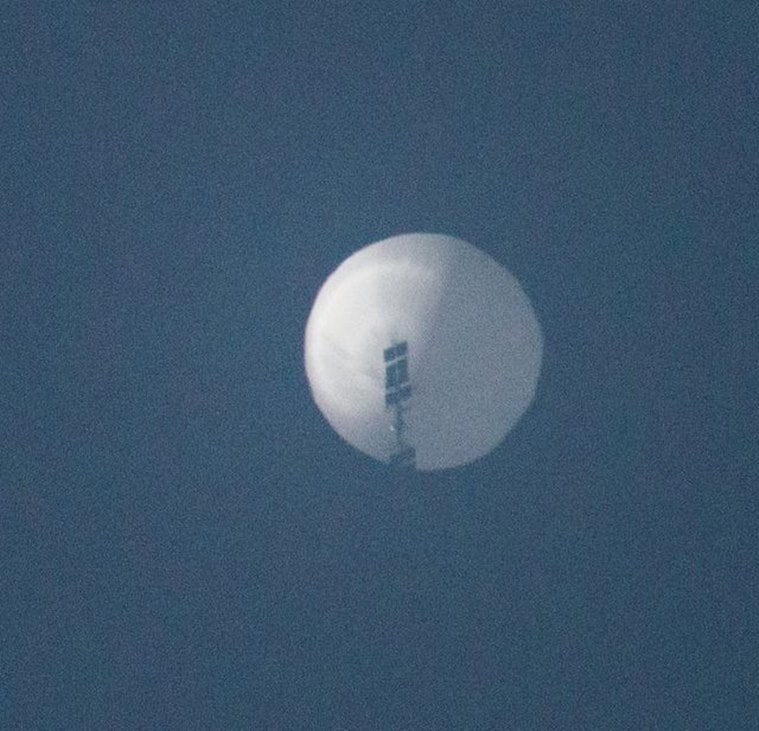‘Spy balloon’ is latest flashpoint between US, China: what is this age-old military device?
Using balloons for reconnaissance and other military missions dates as far back as the late 18th century. High-altitude balloons have been used since World War II.
 A high altitude balloon floats over Billings, Montana, on Wednesday, Feb 1, 2023. (Larry Mayer/The Billings Gazette via AP)
A high altitude balloon floats over Billings, Montana, on Wednesday, Feb 1, 2023. (Larry Mayer/The Billings Gazette via AP)
The United States has accused China of flying a “spy balloon” in its airspace. Beijing has responded, calling the object “a civilian airship used for meteorological research”. The incident has caught public imagination and set off a political row in Washington after it was seen floating over sensitive areas of Montana in the US. Officials claim the white balloon is the size of three buses and is carrying a “large” payload.
Within hours of the news of the first balloon, the Pentagon confirmed that a second “surveillance” balloon is floating over the Latin American skies and that the officials are keeping an eye on it. As per a CNN report, the exact location of the second balloon is unclear, but it does not look like it is heading toward the United States.
Beijing, however, has dismissed Washington’s accusations of surveillance and international airspace violation as an attempt to “attack and smear China.” “Regarding the unintended entry of a Chinese unmanned airship into US airspace due to force majeure, the Chinese side has verified it and communicated it to the US side. It is a civilian airship used for research, mainly meteorological, purposes. Affected by the Westerlies and with limited self-steering capability, the airship deviated far from its planned course. This is entirely an unexpected situation caused by force majeure and the facts are very clear,” the country’s Foreign Ministry spokesperson said in a media briefing on Friday.
The incident prompted Secretary of State Antony Blinken to postpone his China visit next weekend. A local media said that Blinken was playing it safe, not wanting to blow the situation out of proportion by cancelling his visit, but also not wanting the meeting to be dominated by the issue.
A ‘UFO’ turned ‘spy balloon’
Word of something unusual in the skies over Billings, Montana first spread on Wednesday afternoon when a “ground stop” was placed on regional airports. No flights, including commercial air traffic, could land or depart in a 50-mile radius that included the Billings airport, reported Billings Gazette. Air traffic has since resumed.
From an office window in Billings, Chase Doak said he saw a “big white circle in the sky”, that he said was too small to be the Moon, reported The Associated Press. “I thought maybe it was a legitimate UFO… So I wanted to make sure I documented it and took as many photos as I could.”
But the Pentagon’s statement dismissed conspiracy theories that pointed towards extra-terrestrial activity, shifting focus to China instead. A senior DOD official told The AP that the US has “very high confidence” it is a Chinese high-altitude balloon and it was flying over sensitive sites to collect information.
The US’s response
President Joe Biden was briefed on the matter, but advised against taking “kinetic action” as debris from the balloon could pose a threat to life and property on the ground. Currently, “the balloon is well above commercial air traffic and does not pose a threat to civil aviation,” said Brig. Gen. Ryder in his statement. He also announced that upon detecting the high-flying balloon, the US had “taken immediate steps” to protect sensitive information, but did not divulge specifics, The AP reported.
House Speaker Kevin McCarthy (R-Calif.) tweeted, “China’s brazen disregard for US sovereignty is a destabilising action that must be addressed”.
“From the spy balloon to the Chinese Communist Party spying on Americans through TikTok to CCP-linked companies buying American farmland, I’m deeply troubled by the constant stream of alarming developments for our national security,” said Montana Governor Greg Gianforte in a statement.
Escalating tensions between the US, China
The relationship between the US and China have been tense in recent times, with issues ranging from Taiwan and the South China Sea, to human rights in China’s western Xinjiang region and the clampdown on democracy activists in Hong Kong.
Taiwan specifically has been at the centre of US- China animosity, ever since former House Speaker Nancy Pelosi visited the island nation claimed by China as its own. On Tuesday, Taiwan scrambled fighter jets, put its navy on alert and activated missile systems in response to nearby operations by 34 Chinese military aircraft and nine warships, reported The AP. These operations are a part of China’s ongoing attempt to intimidate and unsettle Taiwan as well as test the West’s resolve on the matter.
Blinken’s visit this weekend was meant to thaw relationships and find common ground. Only time will tell whether it will achieve its goals or indeed take place.
 A balloon flies in the sky over Billings, Montana, U.S. February 1, 2023, in this picture obtained from social media. (Chase Doak/via Reuters)
A balloon flies in the sky over Billings, Montana, U.S. February 1, 2023, in this picture obtained from social media. (Chase Doak/via Reuters)
The spy balloon, an age-old military device
Around a decade-and-a-half after the first ever hot air balloon took flight with humans, balloons were already being used for military purposes. During the French Revolutionary Wars in the late 18th century, balloons were used to provide a bird’s eye view of the battlefield, with there being documented evidence of their use in the Battle of Fleurus in 1794.
Since then, balloons have been in use in all kinds of conflict, from the American Civil War to World War I. For well over a century, before aircraft technology really took off during the Great War, balloons were the primary mode of big-picture reconnaissance, providing perspective on enemy positions and movements simply impossible to obtain from the ground.
During World War II, as technologies evolved and balloons could be pushed to higher altitudes, their use evolved as well. For instance, the Japanese military tried to loft incendiary bombs into US territory using balloons designed to float in jet stream air currents. No military targets were damaged, but several civilians were killed when one of the balloons crashed in an Oregon forest.
After the war, the US military started exploring the use of high-altitude spy balloons, which led to a large-scale series of missions called Project Genet. The project flew photographic balloons over Soviet bloc territory in the 1950s – a time before the sheer ubiquitousness of surveillance satellites we see today.
How relevant are high-altitude balloons today?
While satellites and improved aeroplane and drone technologies have reduced the salience of high-altitude balloons in the military, they still occupy an important niche.
Unlike satellites which can cost millions of dollars to create, and require sophisticated technology to launch, high-altitude balloons are cheap and easy to launch and control. While balloons cannot directly be steered, they can be roughly guided to a target area by changing altitudes to catch different wind currents, according to a 2005 study for the Air Force’s Airpower Research Institute, reported Reuters.
Moreover, unlike satellites which are at much higher altitudes and moving at incredible speeds, spy balloons have the advantage of being able to hover around at lower heights, thus providing better quality images as well as more time to gather intelligence in a particular area.
The latest incident, in which the balloon not only reached mainland US but has since been able to operate uninterrupted, only highlights its continued relevance.
- 01
- 02
- 03
- 04
- 05






































